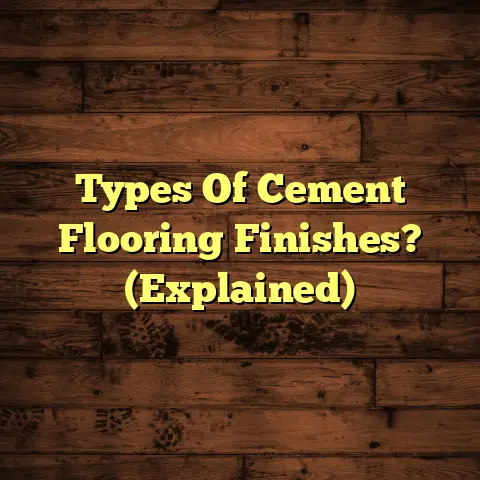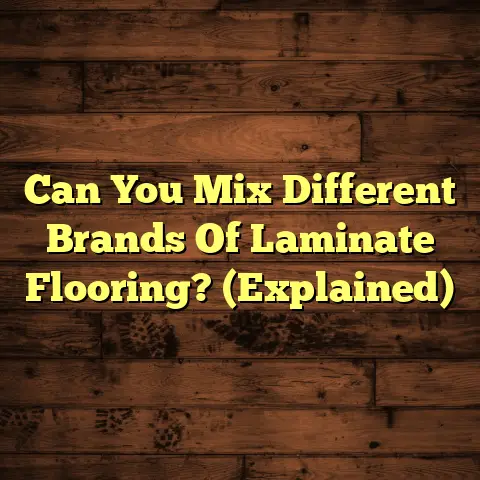Hardwood Finishing Cost/SqFt? (2 Prices Shock Pros!)
From the sweltering humidity of Florida to the bone-dry air of Arizona, I’ve learned that the climate you’re in plays a HUGE role in what finish you choose and, more importantly, how much it’s gonna cost you.
Have you ever heard two pros quoting wildly different prices for the same job? It’s more common than you think! Today, we’re diving deep into the world of hardwood finishing costs, breaking down all the factors that influence the price per square foot.
Ready to get started? Let’s jump in!
Section 1: Overview of Hardwood Finishing
So, what exactly is hardwood finishing? Simply put, it’s the process of applying a protective coating to your hardwood floors. This coating not only enhances the natural beauty of the wood, but it also shields it from scratches, stains, and everyday wear and tear.
Think of it as armor for your floors!
There are tons of different finishes out there, each with its own unique characteristics:
-
Oil-Based Polyurethane: This is your classic, durable option. It provides a warm, amber hue and is known for its resistance to abrasion and chemicals. However, it does have a strong odor and longer drying time.
-
Water-Based Polyurethane: A more eco-friendly alternative to oil-based, water-based finishes are low in VOCs (volatile organic compounds) and dry much faster. They also tend to be clearer, allowing the natural color of the wood to shine through.
-
Moisture-Cured Urethane: This is a super durable finish, often used in commercial settings. It’s highly resistant to water and chemicals, but it’s also more expensive and requires specialized application.
-
Penetrating Oil Finishes: These finishes, like tung oil or linseed oil, penetrate the wood fibers, providing a natural look and feel. They’re easy to repair but require more frequent maintenance.
-
Wax Finishes: Wax provides a beautiful, low-luster sheen. It’s easy to apply and repair, but it’s not very durable and needs to be reapplied regularly.
Before any finish can be applied, the floor needs to be properly prepped. This usually involves sanding down the old finish (if there is one) and cleaning the surface to remove any dust or debris. Trust me, a good prep job is half the battle!
Section 2: Factors Influencing Hardwood Finishing Costs
Alright, let’s get down to the nitty-gritty: what actually drives the cost of hardwood finishing? There are several key factors at play.
Material Costs
The type of finish you choose will have a significant impact on the overall cost. Here’s a general idea of what you can expect to pay per square foot for materials only:
- Oil-Based Polyurethane: \$2 – \$4 per square foot
- Water-Based Polyurethane: \$3 – \$6 per square foot
- Moisture-Cured Urethane: \$5 – \$8 per square foot
- Penetrating Oil Finishes: \$2 – \$5 per square foot
- Wax Finishes: \$1 – \$3 per square foot
These are just estimates, of course. Prices can vary depending on the brand, quality, and retailer. Always shop around to get the best deal!
Labor Costs
Labor costs can vary widely depending on your location, the experience level of the contractor, and the complexity of the job. Are we talking a simple refinish or a complete overhaul?
In general, you can expect to pay anywhere from \$2 to \$8 per square foot for labor. Highly experienced contractors in major metropolitan areas will likely charge more than less experienced contractors in rural areas.
Think of it this way: you’re not just paying for the labor itself, but also for the contractor’s expertise, insurance, and overhead costs.
Geographical Variations
This is where things get interesting! The cost of hardwood finishing can vary dramatically from one region to another.
Urban areas tend to have higher labor costs due to the higher cost of living. Additionally, some states have specific regulations or standards that can impact pricing.
For example, California has strict VOC regulations, which can drive up the cost of certain finishes.
I once worked on a project in San Francisco where the labor costs were almost double what I would have charged for the same job in rural Montana!
Climate-Specific Needs
As I mentioned earlier, climate plays a crucial role in the choice of finish and, consequently, the cost.
-
Humid Climates: In humid environments, like the Southeast, moisture can be a major problem for hardwood floors. You’ll want to choose a finish that is highly water-resistant and can withstand fluctuations in humidity levels. Oil-based polyurethanes and moisture-cured urethanes are often good choices, but they can be more expensive.
-
Arid Climates: In dry climates, like the Southwest, hardwood floors can dry out and crack. You’ll want to choose a finish that is flexible and can prevent the wood from losing too much moisture. Penetrating oil finishes and water-based polyurethanes are often good choices.
-
Areas with Extreme Temperature Swings: If you live in an area with drastic temperature changes, like the Midwest, you’ll need a finish that can handle both heat and cold. Polyurethane finishes are generally a good option, as they are durable and resistant to cracking.
Here’s a table summarizing the best finish options based on climate:
| Climate | Recommended Finishes | Considerations |
|---|---|---|
| Humid | Oil-Based Polyurethane, Moisture-Cured Urethane | High water resistance is crucial. Ensure proper ventilation during application due to strong odors. |
| Arid | Penetrating Oil Finishes, Water-Based Polyurethane | Focus on flexibility to prevent cracking from dryness. Regular maintenance is required for oil finishes to replenish moisture. |
| Extreme Temperature | Polyurethane Finishes (Oil or Water-Based) | Durability and resistance to cracking are key. Proper acclimation of wood before finishing is important to minimize expansion/contraction. |
| Coastal | Moisture-Cured Urethane, Marine-Grade Finishes | High resistance to salt and moisture is essential. Regular cleaning to remove salt deposits is recommended. |
| Mountainous | Water-Based Polyurethane, Penetrating Oil Finishes | UV protection is important at higher altitudes. Choose finishes that allow for wood expansion/contraction due to temperature fluctuations. |
Section 3: A Detailed Breakdown of Costs Per Square Foot
Okay, let’s put it all together and look at some real-world cost estimates. Keep in mind that these are just averages, and your actual costs may vary.
DIY vs. Professional Finishing:
-
DIY: If you’re a handy person and willing to put in the time and effort, you can save money by finishing your hardwood floors yourself. However, keep in mind that it’s a labor-intensive process, and you’ll need to invest in the right tools and equipment. Plus, if you mess up, you could end up costing yourself more in the long run. The cost of a DIY project is \$3 – \$8 per sqft.
-
Professional: Hiring a professional flooring contractor will cost more upfront, but it can save you time, hassle, and potential headaches. A good contractor will have the experience and expertise to ensure a high-quality finish that lasts for years to come. The cost of hiring a professional is \$4 – \$14 per sqft.
Average Costs Per Square Foot (Including Materials and Labor):
- Oil-Based Polyurethane: \$4 – \$12 per square foot
- Water-Based Polyurethane: \$5 – \$14 per square foot
- Moisture-Cured Urethane: \$7 – \$16 per square foot
- Penetrating Oil Finishes: \$4 – \$13 per square foot
- Wax Finishes: \$3 – \$8 per square foot
Case Studies:
-
Case Study 1: Refinishing 500 sq ft of oak flooring with oil-based polyurethane in Atlanta, GA:
- Materials: \$1,500 (\$3/sq ft)
- Labor: \$2,500 (\$5/sq ft)
- Total Cost: \$4,000 (\$8/sq ft)
-
Case Study 2: Refinishing 800 sq ft of maple flooring with water-based polyurethane in Denver, CO:
- Materials: \$3,200 (\$4/sq ft)
- Labor: \$4,000 (\$5/sq ft)
- Total Cost: \$7,200 (\$9/sq ft)
Section 4: The Price Shock: Dissecting Two Real-World Scenarios
Alright, let’s talk about those price shocks I mentioned earlier. I’m going to share two real-world scenarios that highlight how climate and finish choices can drastically impact the final cost.
Scenario 1: Low-End Finish in a Humid Climate
I had a client in Miami, Florida, who wanted to refinish their 1,000 sq ft hardwood floors on a tight budget. They opted for a low-cost, water-based polyurethane to save money upfront.
Here’s the breakdown:
- Finish: Low-cost water-based polyurethane (\$2/sq ft)
- Labor: \$4/sq ft (relatively low due to the simplicity of the job)
- Total Cost: \$6,000
Sounds good, right? Wrong!
Within a year, the finish started to peel and crack due to the high humidity levels. The client ended up having to pay me again to sand down the floors and apply a more suitable, oil-based polyurethane.
- Original Cost: \$6,000
- Cost of Repair: \$8,000 (including new materials and labor)
- Total Cost: \$14,000
Ouch! By trying to save money upfront, they ended up spending more than double in the long run.
Scenario 2: High-End Finish in an Arid Climate
On the other hand, I had a client in Scottsdale, Arizona, who wanted the best possible finish for their 800 sq ft hardwood floors. They opted for a high-end, penetrating oil finish.
Here’s the breakdown:
- Finish: High-end penetrating oil finish (\$5/sq ft)
- Labor: \$6/sq ft (requires specialized application)
- Total Cost: \$8,800
While this was a significant investment, the client understood the importance of protecting their floors in the dry desert climate. The penetrating oil finish helped to prevent the wood from drying out and cracking, ensuring that their floors would look beautiful for years to come.
In this case, the higher upfront cost was a worthwhile investment in the long-term health and beauty of their floors.
Analysis
These two scenarios illustrate a crucial point: the cheapest option is not always the best option.
In the humid climate, the low-cost finish failed to provide adequate protection, leading to costly repairs. In the arid climate, the high-end finish provided the necessary protection, preventing potential damage and saving the client money in the long run.
Section 5: Additional Costs to Consider
Before you sign on the dotted line, there are a few other potential costs to keep in mind.
-
Repairs: If your floors have any existing damage, such as water stains, cracks, or gouges, you’ll need to factor in the cost of repairs. These can range from a few hundred dollars to several thousand, depending on the extent of the damage.
-
Subfloor Issues: In some cases, the subfloor (the layer beneath the hardwood flooring) may need to be repaired or replaced. This can add significant cost to the project.
-
Furniture Removal: You’ll need to clear the room of all furniture before the finishing process can begin. Some contractors may include furniture removal in their price, while others may charge extra.
-
Acclimation: Hardwood flooring needs to acclimate to the environment before it’s installed or refinished. This means allowing the wood to sit in the room for several days to adjust to the temperature and humidity levels. Failure to acclimate the wood can lead to warping or cracking.
-
Ongoing Maintenance: Different finishes require different levels of maintenance. Penetrating oil finishes, for example, need to be reapplied regularly to maintain their protective properties. Be sure to factor in these ongoing costs when making your decision.
Conclusion
So, there you have it: a comprehensive guide to understanding the costs of hardwood finishing. As you’ve seen, there are many factors that can influence the price per square foot, including the type of finish, labor costs, geographical variations, and climate-specific needs.
Remember, the key to making an informed decision is to do your research, get multiple quotes from qualified contractors, and carefully consider your specific needs and circumstances. Don’t be afraid to ask questions and get clarification on any aspect of the project.
By taking the time to understand the costs involved, you can ensure that you get the best possible finish for your hardwood floors at a price that fits your budget. And who knows, you might even avoid a price shock or two along the way! Good luck with your flooring project!





